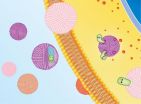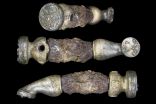(Press-News.org) New York | Heidelberg, 13 October 2014 Increasing reliance on renewable energies is the way to achieve greater CO2 emission sustainability and energy independence. As such energies are yet only available intermittently and energy cannot be stored easily, most countries aim to combine several energy sources. In a new study in EPJ Plus, French scientists have come up with an open source simulation method to calculate the actual cost of relying on a combination of electricity sources. Bernard Bonin from the Atomic Energy Research Centre CEA Saclay, France, and colleagues demonstrate that cost is not directly proportional to the demand level. Although recognised as crude by its creator, this method can be tailored to account for the public's interest—and not solely economic performance—when optimising the energy mix.
The authors consider wind, solar, hydraulic, nuclear, coal and gas as potential energy sources. In their model, the energy demand and availability are cast as random variables. The authors simulated the behaviour of the mix for a large number of tests of such variables, using so-called Monte-Carlo simulations.
For a given mix, they found the energy cost of the mix presents a minimum as a function of the installed power. This means that if it is too large, the fixed costs dominate the total and become overwhelming. In contrast, if it is too small, expensive energy sources need to be frequently solicited.
The authors are also able to optimise the energy mix, according to three selected criteria, namely economy, environment and supply security.
The simulation tested on the case of France, based on 2011 data, shows that an optimal mix is 2.4 times the average demand in this territory. This mix contains a large amount of nuclear power, and a small amount of fluctuating energies: wind and solar. It is also strongly export-oriented.
INFORMATION:
Reference: Bonin, B. et al. (2014). MIXOPTIM: a tool for the evaluation and the optimization of the electricity mix in a territory. European Physical Journal Plus. DOI 10.1140/epjp/i2014-14198-7
For more information visit: http://www.epj.org
The full-text article is available to journalists on request.
Balancing renewable energy costs
Simulating the cost of generating a combination of electricity sources provides tools to optimize such energy mix
2014-10-14
ELSE PRESS RELEASES FROM THIS DATE:
Ultra-fast charging batteries that can be 70 percent recharged in just 2 minutes
2014-10-14
Scientists from Nanyang Technological University (NTU Singapore) have developed a new battery that can be recharged up to 70 per cent in only 2 minutes. The battery will also have a longer lifespan of over 20 years.
Expected to be the next big thing in battery technology, this breakthrough has a wide-ranging impact on many industries, especially for electric vehicles which are currently inhibited by long recharge times of over 4 hours and the limited lifespan of batteries.
This next generation of lithium-ion batteries will enable electric vehicles to charge 20 times ...
Older women more likely to have multiple health conditions
2014-10-14
In the context of an aging population, the number of cases of people with multimorbidity, or multiple health conditions, is increasing, creating significant healthcare challenges. Now, the first comprehensive systematic review in this field has found higher levels of multimorbidity in women. Equally as importantly, it has revealed the poor quality of evidence on this increasingly critical area of healthcare.
The review's main author, Professor Jose M Valderas, NIHR Clinician Scientist of the University of Exeter Medical School, is calling for better quality research to ...
Bio-inspired 'nano-cocoons' offer targeted drug delivery against cancer cells
2014-10-14
Biomedical engineering researchers have developed a drug delivery system consisting of nanoscale "cocoons" made of DNA that target cancer cells and trick the cells into absorbing the cocoon before unleashing anticancer drugs. The work was done by researchers at North Carolina State University and the University of North Carolina at Chapel Hill.
"This drug delivery system is DNA-based, which means it is biocompatible and less toxic to patients than systems that use synthetic materials," says Dr. Zhen Gu, senior author of a paper on the work and an assistant professor in ...
Cushing's syndrome: LCSB researchers characterize a new tumor syndrome
2014-10-14
Scientists at the Luxembourg Centre for Systems Biomedicine (LCSB) of the University of Luxembourg have published their findings that mutations in a gene known as "ARMC5" promote the growth of benign tumours in the adrenal glands and on the meninges: ARMC5 appears to belong to the group of so-called tumour suppressor genes. It is the first time in years that scientists have characterized such a gene.
The ARMC5 gene was discovered by independent workgroups studying benign tumours – so-called adrenal adenomas – in connection with Cushing's syndrome. In this ...
University of Leicester archaeologists discover bronze remains of Iron Age chariot
2014-10-14
University of Leicester archaeologists have made a "once-in-a-career" discovery of the decorated bronze remains of an Iron Age chariot.
A team from the University's School of Archaeology and Ancient History has unearthed a hoard of rare bronze fittings from a 2nd or 3rd century BC chariot which appears to have been buried as a religious offering.
The archaeologists found the remains during their ongoing excavation of the Burrough Hill Iron Age hillfort, near Melton Mowbray, Leicestershire.
The School has led a 5-year project there since 2010, giving archaeology students ...
Disputed theory on Parkinson's origin strengthened
2014-10-14
Parkinson's disease is strongly linked to the degeneration of the brain's movement center. In the last decade, the question of where the disease begins has led researchers to a different part of the human anatomy. In 2003, the German neuropathologist Heiko Braak presented a theory suggesting that the disease begins in the gut and spreads to the brain. The idea has since, despite vocal critics, gained a lot of ground. Researchers at Lund University in Sweden now present the first direct evidence that the disease can actually migrate from the gut to the brain.
The so-called ...
Magnetic superconductor: Strange bedfellows
2014-10-14
Chemists at Ludwig-Maximilias-Universitaet (LMU) in Munich have synthesized a ferromagnetic superconducting compound that is amenable to chemical modification, opening the route to detailed studies of this rare combination of physical properties.
Superconductivity and ferromagnetism – the "normal" form of magnetism, such as that found in the familiar horseshoe magnet – are like chalk and cheese: They generally don't go together. Ferromagnets are magnetic because the parallel alignment of adjacent electron spins in the iron atoms generates a strong internal ...
Rising sea levels of 1.8 meters in worst-case scenario
2014-10-14
The climate is getting warmer, the ice sheets are melting and sea levels are rising – but how much? The report of the UN's Intergovernmental Panel on Climate Change (IPCC) in 2013 was based on the best available estimates of future sea levels, but the panel was not able to come up with an upper limit for sea level rise within this century. Now researchers from the Niels Bohr Institute and their colleagues have calculated the risk for a worst-case scenario. The results indicate that at worst, the sea level would rise a maximum of 1.8 meters. The results are published ...
The chemistry of pizza (video)
2014-10-14
WASHINGTON, Oct. 13, 2014 — Whether it's a plain cheese, a deep-dish stacked with meats or a thin-crust veggie delight, there's just something about pizza that makes it delicious. There's a lot of chemistry that goes into everything from dough to sauce to toppings to, of course, cheese. There's also a very specific chemical reaction at work on every single slice, no matter what toppings you choose. Check out the latest episode here: http://youtu.be/tOkCgAwhh9U.
Subscribe to the series at Reactions YouTube, and follow us on Twitter @ACSreactions to be the first to ...
Oral drug reduces formation of precancerous polyps in the colon, UB researchers find
2014-10-14
BUFFALO, N.Y. — An oral biologic medication has successfully treated chronic, precancerous inflammation in the intestine, according to results of an animal study authored by an MD/PhD student in the University at Buffalo School of Medicine and Biomedical Sciences.
The study is featured on the cover of the current issue of Cancer Research; it was published online ahead of print in September. The journal's editors characterized the study's findings as "striking."
Inflammatory cells in the colon, or polyps, are very common after the age of 50. The average 60-year-old ...
LAST 30 PRESS RELEASES:
Scalable and healable gradient textiles for multi‑scenario radiative cooling via bicomponent blow spinning
Research shows informed traders never let a good climate crisis go to waste
Intelligent XGBoost framework enhances asphalt pavement skid resistance assessment
Dual-function biomaterials for postoperative osteosarcoma: Tumor suppression and bone regeneration
New framework reveals where transport emissions concentrate in Singapore
NTP-enhanced lattice oxygen activation in Ce-Co catalysts for low-temperature soot combustion
Synergistic interface engineering in Cu-Zn-Ce catalysts for efficient CO2 hydrogenation to methanol
COVID-19 leaves a lasting mark on the human brain
Scientists use ultrasound to soften and treat cancer tumors without damaging healthy tissue
Community swimming program for Black youth boosts skills, sense of belonging, study finds
Specific depressive symptoms in midlife linked to increased dementia risk
An ‘illuminating’ design sheds light on cholesterol
Who is more likely to get long COVID?
Study showcases resilience and rapid growth of “living rocks”
Naval Research Lab diver earns Office of Naval Research 2025 Sailor of the Year
New Mayo-led study establishes practical definition for rapidly progressive dementia
Fossil fuel industry’s “climate false solutions” reinforce its power and aggravate environmental injustice
Researchers reveal bias in a widely used measure of algorithm performance
Alcohol causes cancer. A study from IOCB Prague confirms damage to DNA and shows how cells defend against it
Hidden viruses in wastewater treatment may shape public health risks, study finds
Unlock the power of nature: how biomass can transform climate mitigation
Biochar reshapes hidden soil microbes that capture carbon dioxide in farmland
Reducing saturated fat intake shows mortality benefit, but only in high-risk individuals
Manta rays create mobile ecosystems, study finds
Study: Mixed results in using lipoic acid to treat progressive multiple sclerosis
Norbert Holtkamp appointed director of Fermi National Accelerator Laboratory
New agentic AI platform accelerates advanced optics design
Biologists discover neurons use physical signals — not electricity — to stabilize communication
Researchers discover that a hormone can access the brain by hitchhiking
University of Oklahoma researcher awarded funding to pursue AI-powered material design
[Press-News.org] Balancing renewable energy costsSimulating the cost of generating a combination of electricity sources provides tools to optimize such energy mix




